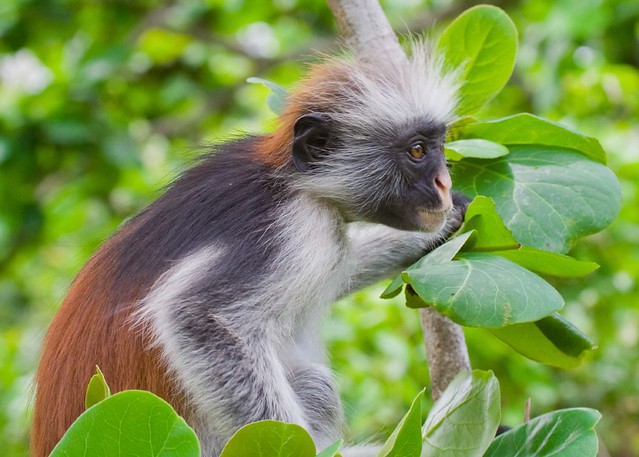The members of this subgenus are found in western, central and eastern Africa, and the species have largely allo- or parapatric distributions. Most are restricted to humid forests, but the Zanzibar red colobus prefers coastal thickets and scrub. Red colobuses are primarily arboreal and are highly sensitive to hunting and habitat destruction, and have been referred to as probably the most threatened taxonomic group of primates in Africa.[4] If following the taxonomic treatment advocated in Mammal Species of the World,[1] all species except the Central African red colobus are assessed by the IUCN as endangered or critically endangered.[5]
Social behavior
Groups often establish a dominance hierarchy determined by aggressive behavior. Food, grooming, and sexual partners are distributed amongst higher-ranking individuals initially, followed by lower-ranking individuals.[6] They live in large troops which can number up to 80 individuals, the average being somewhere around 20 to 40 monkeys. These groups tend to have more females than males at a 2:1 ratio. The few male monkeys in the troop usually stay with their original group, but the females have a tendency to move together in small numbers, probably in close familial relationships, between troops. Red colobus monkeys have overlapping ranges with other troops. Interactions between troops can be either tense, though passive, or violent, with one troop trying to supplant the other. These fights are usually based on a number of factors including physical condition, fighting ability, and the number of males in the opposing troop. Females are also known to take part in these competitions for dominance, and often fight together. Mother-infant bonds among the red colobus are quite strong, as they are with most primates. The mothers are usually reluctant to allow other females from their troop to carry their babies. This may be owing to the fact that many of the females in a troop are not related as they move between groups quite frequently.[7]
Another remarkable behavior occurs when red colobus monkeys reach their restless and somewhat nomadic adolescence. This period is when the young monkeys leave their natal troops and look for another troop to join. This is not easy, as most troops are very suspicious and can get deadly when new monkeys try to join. The red colobus monkeys have adapted their behavior by joining troops of green monkeys that are near the potential red colobus troops that they wish to join, and living amongst them in order to spy on their potential new families. In one notable case, an adolescent male red colobus spent two years with a green monkey troop in order to spy in safety on a prospective troop in this manner.[8]
Diet

The diet of red colobus monkeys consists mainly of young leaves, flowers, and unripe fruit.[9] They are also known to eat charcoal or clay to help combat the cyanide some leaves may contain. This medicinal cure for the plants they eat appears to be passed on from mother to child.[10] However, their stomachs are able to digest some toxic plants that other primates cannot.[9] Red colobus monkeys are extraordinarily adapted to their entirely vegetarian and widely varied diet. They have special salivary glands, which are larger and produce more specialized saliva to help facilitate the breakdown of leaves before they even reaches their digestive tract. The stomach of the red colobus is also sacculated into four chambers (similar to unrelated ungulates) and larger than those of other monkeys of a comparative size. This allows for longer digestion, so that most nutrients can be gleaned from the relatively low nutrient food.[11]
Chimpanzee predation
Research indicates that chimpanzee predation may be a major selection factor on some red colobus populations.[12] Although chimpanzees primarily eat fruit, leaves, and insects, if the opportunity to eat meat rises, they will pursue it. In addition to sustenance, evidence suggests that chimpanzees prey on red colobus to reinforce social status, as well as to attract sexual partners.[13] When under attack, the red colobus males congregate to defend their group, while the females gather their infants and try to escape. Larger groups of red colobuses have an increased likelihood of attracting chimpanzees, but they also tend to have more defending males, making it harder for chimpanzees to hunt successfully.[14] Furthermore, while under attack, male colobuses shout an alarm call to let others know if chimpanzees or other predators are in the area. The frequency of these shouts is increased with the number of females and infants in the group as a way to spread the news of an expected attack.[15] At Gombe National Park in Tanzania C.B. Stanford estimated that the Gombe chimps kill up to 100 colobus monkeys a year, which he believes to be close to a fifth of the colobus population within their territory.[16] Another study confirms that chimpanzees are annually responsible for 6-12 percent of red colobus female and infant death in Ngogo, Kibale National Park, which has one of the largest populations of chimpanzees. It seems that chimpanzees tend to favor the red colobus as prey whenever the two are in the same territory, hunting in groups of up to 20 individual chimps. During these hunts in Tai, Gombe, Ngogo, and Mahale National Parks, ≥ 87 percent of the hunts made more than one kill. The highest amount of kills seen during this study was 13, most of which were infants.[17]

No comments:
Post a Comment
Note: Only a member of this blog may post a comment.